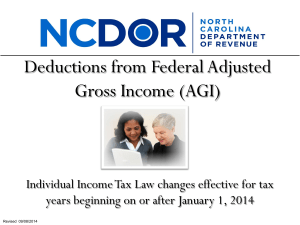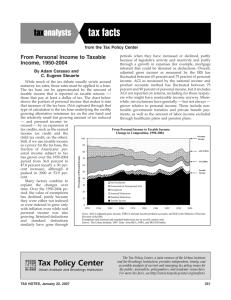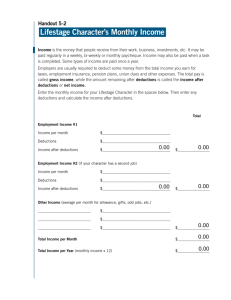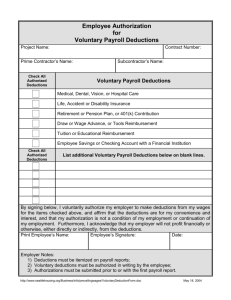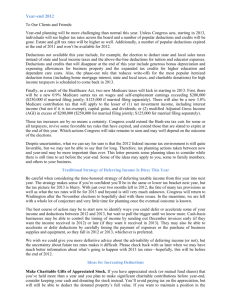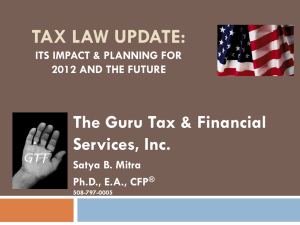Itemized Deduction Limitations
advertisement
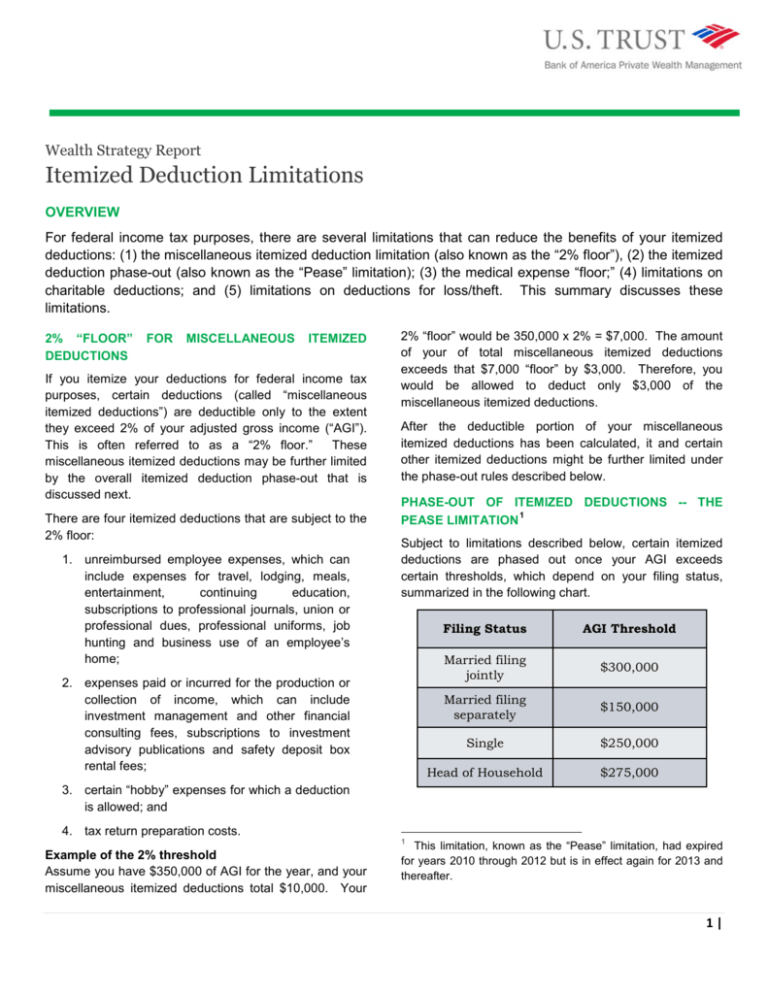
Wealth Strategy Report Itemized Deduction Limitations OVERVIEW For federal income tax purposes, there are several limitations that can reduce the benefits of your itemized deductions: (1) the miscellaneous itemized deduction limitation (also known as the “2% floor”), (2) the itemized deduction phase-out (also known as the “Pease” limitation); (3) the medical expense “floor;” (4) limitations on charitable deductions; and (5) limitations on deductions for loss/theft. This summary discusses these limitations. 2% “FLOOR” DEDUCTIONS FOR MISCELLANEOUS ITEMIZED If you itemize your deductions for federal income tax purposes, certain deductions (called “miscellaneous itemized deductions”) are deductible only to the extent they exceed 2% of your adjusted gross income (“AGI”). This is often referred to as a “2% floor.” These miscellaneous itemized deductions may be further limited by the overall itemized deduction phase-out that is discussed next. There are four itemized deductions that are subject to the 2% floor: 1. unreimbursed employee expenses, which can include expenses for travel, lodging, meals, entertainment, continuing education, subscriptions to professional journals, union or professional dues, professional uniforms, job hunting and business use of an employee’s home; 2% “floor” would be 350,000 x 2% = $7,000. The amount of your of total miscellaneous itemized deductions exceeds that $7,000 “floor” by $3,000. Therefore, you would be allowed to deduct only $3,000 of the miscellaneous itemized deductions. After the deductible portion of your miscellaneous itemized deductions has been calculated, it and certain other itemized deductions might be further limited under the phase-out rules described below. PHASE-OUT OF ITEMIZED DEDUCTIONS -- THE PEASE LIMITATION 1 Subject to limitations described below, certain itemized deductions are phased out once your AGI exceeds certain thresholds, which depend on your filing status, summarized in the following chart. 2. expenses paid or incurred for the production or collection of income, which can include investment management and other financial consulting fees, subscriptions to investment advisory publications and safety deposit box rental fees; Filing Status AGI Threshold Married filing jointly $300,000 Married filing separately $150,000 Single $250,000 Head of Household $275,000 3. certain “hobby” expenses for which a deduction is allowed; and 4. tax return preparation costs. 1 Example of the 2% threshold Assume you have $350,000 of AGI for the year, and your miscellaneous itemized deductions total $10,000. Your This limitation, known as the “Pease” limitation, had expired for years 2010 through 2012 but is in effect again for 2013 and thereafter. 1| You are required to reduce (by up to 80%) the amount of certain otherwise allowable itemized deductions by 3% of the excess of your AGI over these threshold amounts. The following itemized deductions are subject to this limitation: • state and local taxes; • mortgage interest; • charitable contributions; and • miscellaneous itemized deductions The following itemized deductions are not subject to this limitation: • medical expenses (which are already subject to a “floor” of 10%, reduced to 7.5% if one spouse is 65 or older); • investment interest; and • casualty, theft or wagering losses This limitation is applied after the application of any other limitation on the itemized deduction. Thus, this limitation would apply to miscellaneous itemized deductions after the 2% floor has been taken into account. Similarly, this limitation would apply to charitable deductions after the various AGI limitations applicable to charitable deductions have been taken into account. Example of the Pease limitation Assume during 2013, a married couple filing jointly has adjusted gross income of $500,000 and total itemized deductions of $50,000. Of these itemized deductions, $10,000 are miscellaneous itemized deductions, and $40,000 are mortgage interest and taxes. The miscellaneous itemized deductions would be allowed only to the extent they exceed the 2% floor. The 2% floor would be $500,000 x 2% = $10,000. As a result, none the miscellaneous itemized deductions would be allowed; itemized deductions now total $40,000. Next we apply the Pease limitation to the remaining itemized deductions of $40,000. AGI $500,000 Pease Threshold $300,000 Excess of AGI over Threshold $200,000 3% of Excess $ 6,000 The phase-out results in a further reduction in itemized deductions of $6,000. Total allowable itemized deductions would be $40,000 minus $6,000, or $34,000. Understanding the effect of the Pease limitation It is important to understand which particular deductions are reduced by the Pease limitation, otherwise, you can mis-plan. This will depend on your particular tax situation, illustrated in the following two examples. Example 1. Assume you are married filing jointly, your AGI is $650,000, and your itemized deductions are as follows: Itemized Deductions Subject to Pease Limitation State and local taxes $20,000 Mortgage interest $15,000 Charitable contributions (after AGI limitations) $15,000 Misc. itemized deductions (after 2% floor) $ 5,000 TOTAL SUBJECT TO PEASE $55,000 Itemized Deductions NOT Subject to Pease Medical expenses (after 10% floor) $ 7,500 Investment interest $ 4,000 Casualty, theft or wagering losses TOTAL NOT SUBJECT TO PEASE $0 $11,500 Your threshold for purposes of the Pease limitation is $300,000, and your AGI of $650,000 exceeds that by $350,000. The amount of itemized deductions phased out is the lesser of (i) 3% of that excess ($10,500), or (ii) 80% of the $55,000 of deductions subject to the phase out ($44,000). As a result, $10,500 of deductions will be phased out under the Pease limitation. In this Example 1 there are $55,000 of deductions subject to the Pease limitation, and $10,500 of deductions are phased out. Of the four deductions totaling $55,000, which comprise the $10,500 that are phased out by the Pease limitation? There is no ordering rule required by the statute. However, in this Example 1, state/local taxes and mortgage interest must be paid; charitable contributions and the miscellaneous deductions are optional expenditures. From that perspective, it is fair to 2| view the phase-out as denying a deduction for $10,500 of the $35,000 you would have paid anyway for taxes and mortgage interest. To put it another way, given that the $35,000 you paid for taxes and mortgage interest is more than the amount of deductions phased out, your charitable contribution of $15,000 truly increased your itemized deductions by $15,000. Therefore, in this example your charitable contributions are not affected by the Pease limitation. contribution deduction has indeed been reduced by the Pease limitation. Example 2. Assume you are married filing jointly, your AGI is $650,000, and your itemized deductions are as follows: Medical expenses are deductible as an itemized deduction only to the extent they exceed 10% of your AGI. (For years 2013 - 2016, this threshold is reduced to 7.5% if one spouse is 65 or older.) For example, if you have AGI of $300,000, then your threshold amount for medical expenses is $30,000 or 22,500 (depending on whether the 10% or 7.5% threshold applies). Only the amount of medical, dental, and other health care expenses in excess of that threshold can be deducted. Itemized Deductions Subject to Pease Limitation State and local taxes $0 Mortgage interest $0 Charitable contributions (after AGI limitations) Misc. itemized deductions (after 2% floor) TOTAL SUBJECT TO PEASE $55,000 $0 $55,000 Medical expenses (after 10% floor) $ 7,500 Investment interest $ 4,000 TOTAL NOT SUBJECT TO PEASE MEDICAL EXPENSES CHARITABLE CONTRIBUTIONS Itemized Deductions NOT Subject to Pease Casualty, theft or wagering losses In short, the effect of the Pease limitation will depend on the particular itemized deductions you have. You should not assume that charitable contributions will be phased out; they might be (as in Example 2), or they might not be (as in Example 1). $0 $11,500 The totals are the same as from Example 1, and the Pease calculations would again phase out $10,500 of itemized deductions. However, because your only deduction subject to the Pease limitation is the $55,000 charitable contribution, in this Example 2 your charitable Charitable donations are deductible as an itemized deduction but are subject to various “caps” that depend on (i) the type of charity to which you donate (i.e., public charity or private foundation), and (ii) the type of property you donate (i.e., cash, appreciated stock, etc.). We have a separate Wealth Strategy Report discussing this topic: Charitable Income Tax Deductions. CASUALTY OR THEFT LOSS Casualty and theft losses are deductible as an itemized deduction, subject to two limitations. First, for each casualty or theft loss, there is a $100 threshold that must be exceeded. Second, total casualty and theft losses are deductible only to the extent they exceed 10% of your adjusted gross income. — National Wealth Planning Strategies Group Any examples are hypothetical and are for illustrative purposes only. Note: This is not a solicitation, or an offer to buy or sell any security or investment product, nor does it consider individual investment objectives or financial situations. Information in this material is not intended to constitute legal, tax or investment advice. You should consult your legal, tax and financial advisors before making any financial decisions. If any information is deemed “written advice” within the meaning of IRS Regulations, please note the following: IRS Circular 230 Disclosure: Pursuant to IRS Regulations, neither the information, nor any advice contained in this communication (including any attachments) is intended or written to be used, and cannot be used, for the purpose of (i) avoiding tax related penalties or (ii) promoting, marketing or recommending to another party any transaction or matter addressed herein. While the information contained herein is believed to be reliable, we cannot guarantee its accuracy or completeness. U.S. Trust operates through Bank of America, N.A. and other subsidiaries of Bank of America Corporation. Bank of America, N.A., Member FDIC. Mar 2013 ARA054B1 3|
